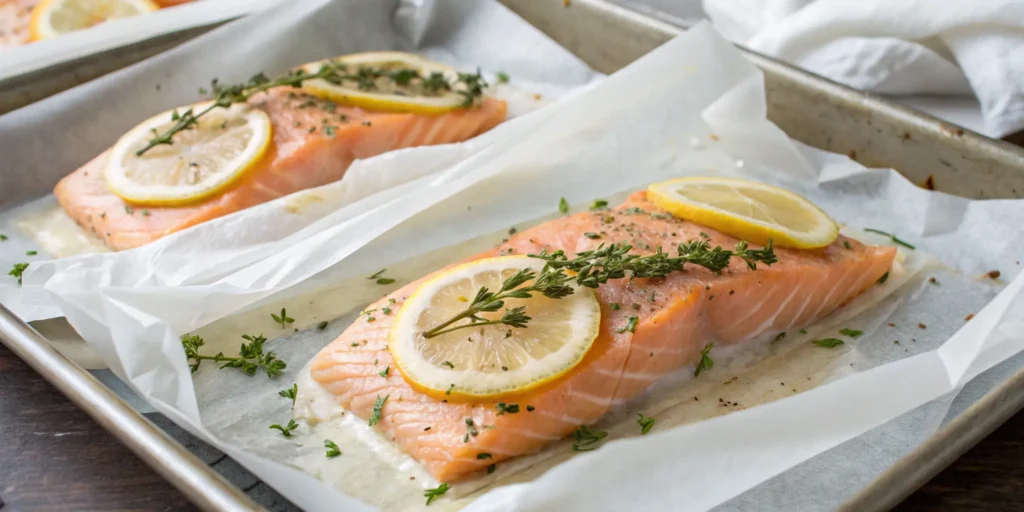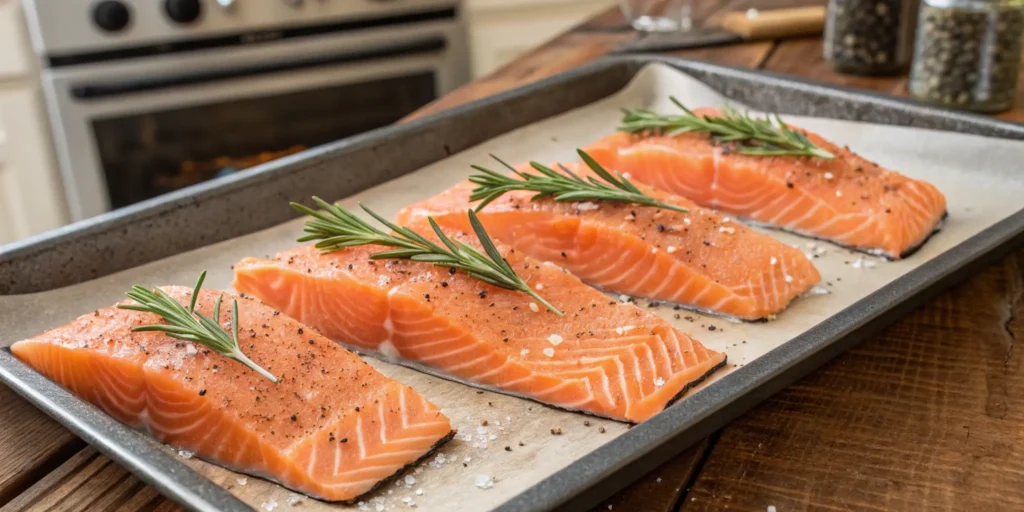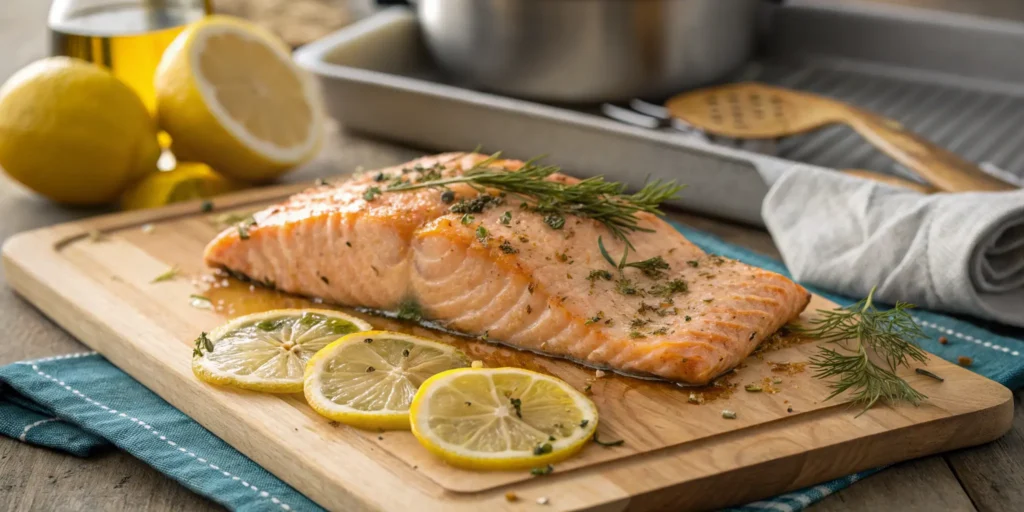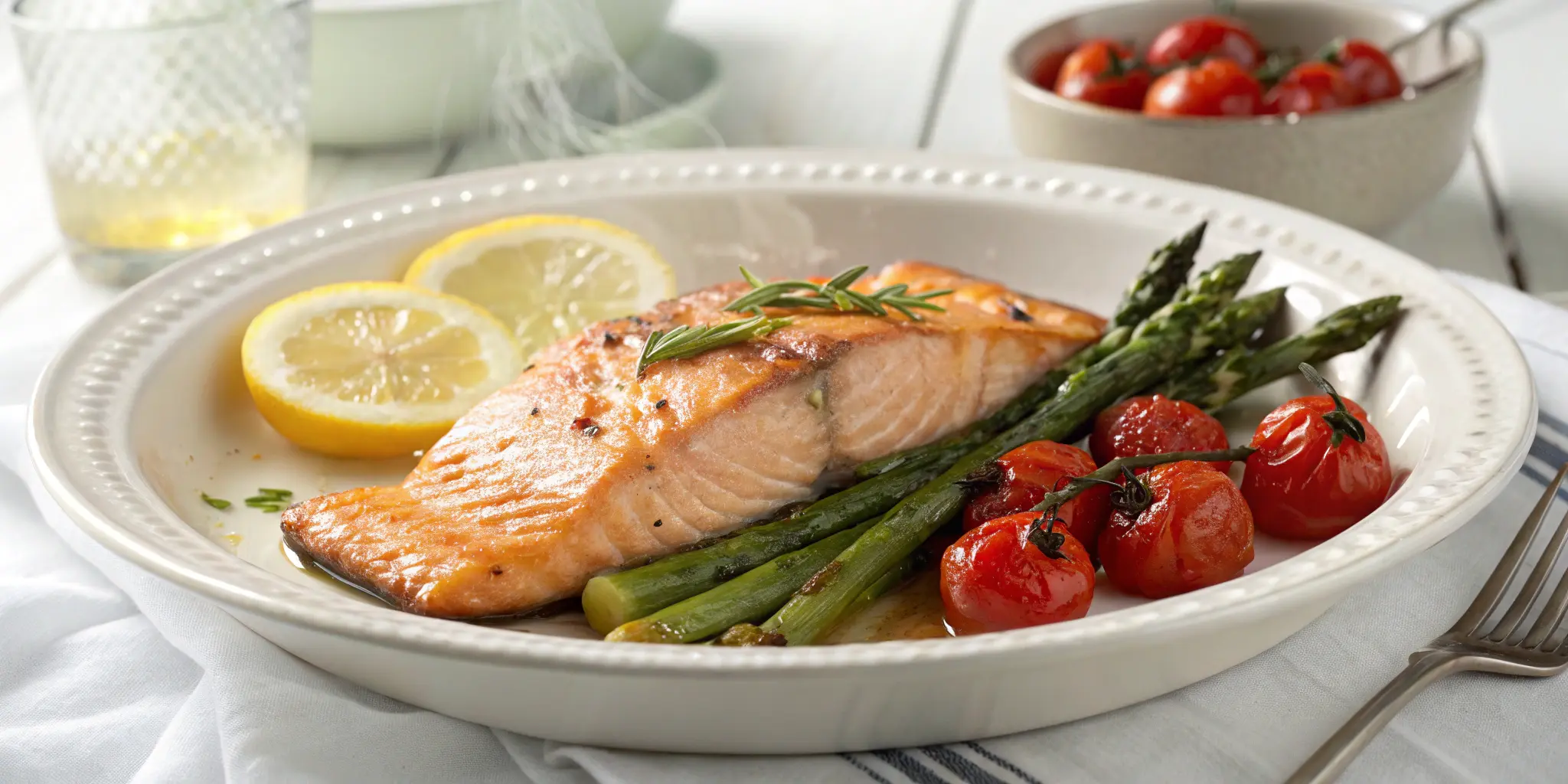Salmon Oven Guide: 3 Best Tips for Juicy Results
Table of Contents
Introduction: Rediscover the Magic of Oven-Baked Salmon
There’s something incredibly satisfying about pulling a perfectly cooked salmon fillet out of the oven. The gentle aroma fills your kitchen, the flaky texture promises tenderness, and the juicy bite is nothing short of divine. But if you’ve ever ended up with a dry, tough piece of fish, you’re not alone. Cooking salmon in the oven can be deceptively simple—yet just a few wrong moves can strip it of its natural moisture.
Maybe you’ve followed a recipe to the letter and still found your salmon turning out less than perfect. Or maybe you’re tired of guessing the right temperature and timing. If so, you’re in the right place. You’re about to learn how to master the salmon oven technique so that every fillet you bake turns out moist, flavorful, and cooked to perfection.
This guide isn’t about complicated recipes or professional kitchen tricks. It’s built for home cooks like you—those who want consistent results without the frustration. You’ll uncover three essential tips that make the difference between dry and juicy salmon. Each one is practical, easy to follow, and rooted in cooking science, not guesswork.
By the time you finish reading, you’ll not only know the ideal cuts, temperatures, and flavor techniques—you’ll be confident putting them into action. Let’s get started.
Tip 1: Choose the Best Cut for Oven Baking
When it comes to cooking salmon in the oven, the cut you choose can either make or break your final result. Not all salmon is created equal, and if you’ve ever wondered why your fish turns out dry or unevenly cooked, the answer often starts with the selection. To consistently get juicy results in the salmon oven, you need to be deliberate about what type of salmon you’re working with.

Why the Right Cut Matters
The oven is a dry-heat environment. Without enough natural fat and moisture in the fish, the heat can cause it to dry out quickly. That’s why selecting the right cut—whether fillets, steaks, or whole sides—directly affects how juicy your salmon turns out.
Here’s what you need to know:
- Fillets are thin, even cuts that cook quickly and evenly. They’re ideal for everyday meals and offer the best control in the oven.
- Steaks are thicker and contain more connective tissue, which can hold moisture well during longer bakes.
- Whole sides of salmon are excellent for entertaining but can be harder to cook evenly without over- or undercooking parts of the fish.
You also want to consider whether the salmon is skin-on or skinless. Skin-on cuts help protect the flesh during baking, locking in moisture and adding an extra layer of flavor. Skinless versions can be more convenient but may dry out more easily if not watched carefully.
Recommended Salmon Varieties for Oven Cooking
Not all types of salmon perform the same in the oven. Some have higher fat content, while others offer bolder flavors. Depending on what you’re going for, here are your top picks:
- Atlantic Salmon: Farm-raised with higher fat content, making it perfect for juicy results in a salmon oven setting.
- Sockeye Salmon: Leaner with a robust, earthy flavor. It’s delicious but needs precise baking to avoid dryness.
- King Salmon (Chinook): The richest in fat and arguably the most forgiving. Ideal for juicy, luxurious baked salmon dishes.
Table: Comparison of Salmon Cuts for Oven Baking
| Salmon Cut | Moisture Level | Oven Cooking Time | Best For |
|---|---|---|---|
| Skin-on Fillet | High | 12–15 minutes | Beginners, reliable juiciness |
| Skinless Fillet | Medium | 10–13 minutes | Quick weeknight meals |
| Salmon Steak | High | 15–20 minutes | Hearty, flavorful dinners |
By starting with the right cut, you’re already setting yourself up for success in your salmon oven journey. You won’t need to rely on sauces or sides to compensate for dryness—your fish will speak for itself.
Tip 2: Master the Oven Temperature and Timing
Even with the best salmon cut in hand, things can still go wrong if your temperature and timing are off. The truth is, the oven can be unforgiving. Overcook your salmon by just a couple of minutes, and you risk losing all its natural juiciness. That’s why understanding how to control heat and time is essential to getting flawless results from your salmon oven experience.

Ideal Oven Settings for Juicy Salmon
The sweet spot for oven-baked salmon sits between 375°F and 400°F (190°C to 205°C). This range allows the fish to cook through evenly without losing too much moisture. Here’s why that matters:
- Lower temperatures like 325°F or 350°F tend to prolong cooking, which can dry out the thinner parts of the fish before the thicker parts finish.
- Higher temperatures above 425°F often cause the outside to cook too fast, leaving you with a flaky surface and a raw interior.
Your best bet? Preheat your oven to 400°F for skin-on fillets or thick steaks, and drop slightly to 375°F if you’re using thinner cuts or skinless pieces.
And don’t skip the preheat step. Putting salmon in a cold or warming oven disrupts even cooking and almost guarantees uneven texture.
Internal Temperature Guidelines
The most reliable way to know if your salmon is done—and still juicy—is by checking its internal temperature with a food thermometer.
- The USDA recommends 145°F (63°C) as the safe minimum internal temperature.
- For softer, restaurant-style texture, remove your salmon at 135°F (57°C) and let it rest for 5 minutes. Residual heat will finish the cooking process without drying the fish.
If you don’t have a thermometer, use a fork to gently flake the center. If it separates easily and the flesh is opaque, it’s done.
Time Chart by Thickness
Not all fillets are created equal in thickness, so time should be adjusted accordingly. Use this quick reference to help guide your bake time based on the thickness of your cut:
| Thickness | Oven Temp | Bake Time |
|---|---|---|
| ½ inch | 375°F | 8–10 minutes |
| 1 inch | 400°F | 12–14 minutes |
| 1½ inches | 400°F | 15–18 minutes |
These aren’t hard rules but solid guidelines. Use them as a starting point, and adjust based on your oven and the cut you’re using. Always keep an eye on your salmon during the final few minutes—it’s better to pull it slightly early and let it rest than to overshoot and end up with a dry piece.
Use Foil or Parchment for Extra Moisture
One easy technique for keeping salmon juicy in the oven is to wrap it in foil or parchment. This creates a gentle steaming effect while baking, trapping natural moisture inside.
- Foil packets are great for locking in flavor along with moisture. You can even add herbs, citrus slices, or a drizzle of olive oil for more complexity.
- Parchment paper offers a lighter touch and is perfect for a healthier, non-metal cooking option.
Both methods are excellent ways to retain moisture and amplify the results from your salmon oven session.
Tip 3: Use Flavor-Enhancing Techniques
Now that you’ve selected the right cut and mastered your oven’s heat and timing, it’s time to elevate the experience. While the natural flavor of salmon is already rich and satisfying, the right seasoning or marinade can enhance its taste and texture—without overpowering it. When used correctly, flavor-enhancing techniques also contribute to keeping the fish juicy in the salmon oven.

Easy Marinades and Seasoning Tips
Marinades serve a dual purpose: they add depth of flavor and act as a moisture barrier during baking. Even 15 to 30 minutes of marinating can make a noticeable difference.
Here are three tried-and-true marinades that work especially well in the oven:
- Lemon Dill Butter: Combines brightness with richness.
- Ingredients: Lemon juice, melted butter, garlic, fresh dill
- Garlic Herb Rub: Bold, earthy, and perfect for herb-lovers.
- Ingredients: Olive oil, minced garlic, parsley, thyme
- Soy Maple Glaze: A sweet-salty blend with an umami kick.
- Ingredients: Soy sauce, maple syrup, minced ginger, garlic
Marinade Reference Table
| Marinade Name | Key Ingredients | Suggested Marination Time |
|---|---|---|
| Lemon Dill Butter | Lemon juice, butter, garlic, fresh dill | 30 minutes |
| Garlic Herb Rub | Olive oil, garlic, parsley, thyme | 20 minutes |
| Soy Maple Glaze | Soy sauce, maple syrup, ginger, garlic | 15–20 minutes |
You don’t need hours to develop flavor—quick marinades penetrate thin fillets quickly. For thicker steaks or sides, go up to 45 minutes but never overnight. Too long in acidic marinades can start to “cook” the fish before it even hits the oven.
Sealing in Moisture with Smart Cooking Techniques
Adding flavor isn’t just about what you put on the fish—it’s also about how you bake it.
- Cook in parchment (en papillote): This French method seals salmon in a parchment pouch, along with herbs, lemon slices, and a splash of liquid like wine or broth. As the oven heats, the pouch inflates, gently steaming the fish.
- Top with moisture-holding ingredients: Add thin lemon slices, herb sprigs, cherry tomatoes, or even a pat of butter right on top of the fillet. These release moisture as they cook, creating a mini steam chamber around your salmon.
- Drizzle before and after baking: A light drizzle of olive oil or a finishing sauce can prevent the fish from drying out once it’s plated.
Don’t rely on sauces to mask dry salmon—instead, let these techniques help you achieve a juicy, flavorful result right out of the salmon oven.
Bonus Section: Simple Salmon Oven Recipe
When you’re ready to put all the techniques together, a reliable go-to recipe is the perfect place to start. This oven-baked salmon recipe is simple, flavorful, and built around everything you’ve learned so far. By using the right cut, temperature, and flavor technique, you’ll consistently get juicy results from your salmon oven efforts.
Baked Lemon Garlic Salmon
This dish is light, aromatic, and fast enough for a weeknight meal. Yet it’s also elegant enough to serve when entertaining. The lemon and garlic combo enhances the natural flavor of the fish without overwhelming it.
Ingredients
Here’s a clear breakdown of what you’ll need:
| Ingredient | Quantity |
|---|---|
| Salmon fillets | 2 (6 oz each) |
| Olive oil | 2 tablespoons |
| Lemon juice | 1 tablespoon |
| Garlic (minced) | 3 cloves |
| Fresh dill or parsley | 1 tablespoon |
| Salt | ½ teaspoon |
| Black pepper | ¼ teaspoon |
| Lemon slices | 4 thin rounds |
You can scale this up or down depending on how many servings you need. Just keep the proportions consistent to ensure balanced flavor.
Instructions
Follow these simple steps to get perfectly juicy salmon from the oven:
- Preheat your oven to 400°F (205°C). Line a baking tray with parchment or foil for easy cleanup.
- Prepare the marinade: In a small bowl, mix the olive oil, lemon juice, minced garlic, salt, and pepper.
- Place the salmon fillets skin-side down on the tray. Spoon the marinade evenly over each fillet.
- Top with fresh herbs and lay lemon slices across each piece of fish.
- Bake for 12–14 minutes, depending on the thickness. The salmon should flake easily with a fork and reach an internal temperature of 135°F–145°F.
- Remove from the oven, let it rest for 5 minutes before serving.
Serving Suggestions
This baked salmon pairs beautifully with:
- Roasted asparagus or green beans
- Quinoa, couscous, or wild rice
- A crisp garden salad with vinaigrette
Whether you’re looking to impress or simply eat well, this recipe is a reliable way to showcase what the salmon oven method can really deliver.
Pro Tips for Consistently Juicy Salmon
Mastering your salmon oven technique doesn’t stop at just cut, temperature, and seasoning. To keep your salmon juicy every time, these extra pointers can make a significant difference. They help you avoid common pitfalls and bring out the best in your bake.
Don’t Overcook—Use a Food Thermometer
Overcooking is the number one cause of dry salmon. The flesh can change from moist to crumbly in minutes. The safest way to prevent this is by using an instant-read food thermometer.
- Insert it into the thickest part of the fillet.
- Pull the salmon when it reaches 135°F (57°C) for that perfectly tender texture.
- Remember, the temperature will continue to rise slightly while resting.
Let the Salmon Rest After Baking
Just like steak or chicken, letting salmon rest for 3 to 5 minutes after it comes out of the oven allows the juices to redistribute inside the fish. This step improves moisture retention and enhances flavor.
Always Preheat Your Oven
Putting salmon into a fully preheated oven ensures even cooking. Starting in a cold or warming oven can result in uneven texture, with some parts overdone and others undercooked.
Use Skin as a Natural Moisture Barrier
If your salmon comes with the skin on, leave it there while baking. The skin acts as a shield, keeping heat from drying out the flesh. You can remove it easily after cooking if you prefer.
Avoid Overcrowding the Baking Tray
Give each fillet or steak enough room on the tray so heat can circulate evenly. Overcrowding traps steam, which can make your salmon soggy or unevenly cooked.
FAQ – Salmon Oven Guide
How long does salmon take in the oven?
Salmon typically takes between 12 to 15 minutes to bake in a salmon oven set at 375°F to 400°F, depending on the thickness of the fillet or steak. Thicker cuts may need closer to 18 minutes, while thinner fillets cook faster.
What is the best temperature to bake salmon in the oven?
The best temperature to bake salmon in the oven is around 400°F (205°C). This temperature balances quick cooking with moisture retention, helping you get tender, juicy salmon without drying it out.
Should I cover salmon when baking in the oven?
Covering salmon with foil or baking it in parchment paper during the salmon oven process helps lock in moisture and prevents drying. It also allows you to infuse flavors with herbs and citrus while the fish gently steams.
How can I tell when salmon is done in the oven?
Salmon is done when the flesh flakes easily with a fork and has turned opaque. Using a food thermometer, the internal temperature should read between 135°F (57°C) for medium-rare and 145°F (63°C) for fully cooked salmon.
Do I need to marinate salmon before baking it in the oven?
Marinating salmon before baking is optional but highly recommended. A quick marinade enhances flavor and adds moisture, especially when cooking in the salmon oven. Even 15 to 30 minutes of marinating can improve the final taste and juiciness.
Conclusion: Master Your Salmon Oven for Perfect Results Every Time
Mastering the salmon oven method is your key to consistently juicy and flavorful salmon dishes. When you use the right cut, control your oven temperature precisely, and apply effective flavor techniques, your salmon oven cooking will never disappoint. The salmon oven creates a perfect environment to lock in moisture and enhance natural flavors, making your meals more enjoyable.
Remember to preheat your salmon oven properly and monitor internal temperatures to avoid overcooking. Resting your fish after baking in the salmon oven helps redistribute juices for maximum tenderness. These simple steps ensure your salmon oven efforts result in flaky, juicy salmon every time.
With the right approach, your salmon oven will become your favorite tool for easy, healthy, and delicious meals. Now that you understand the secrets behind the salmon oven, it’s time to start cooking and impress your family or guests with perfectly baked salmon.
Embrace your salmon oven routine today, and enjoy juicy, mouthwatering salmon dishes that turn every meal into a success.

